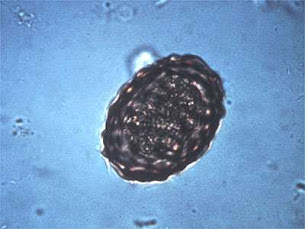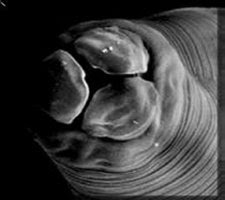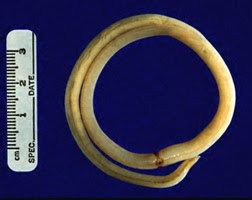Ascaris lumbricoides is a parasite. It is a helminth or more specifically a nematode (roundworm) that undergoes most of its life-cycle within the human body.
The lifecycle of Ascaris Lumbricoides begins when a human ingests viable Ascaris eggs via contaminated soils or composts that may remain on unwashed hands, food, or particularized dust.
When the eggs entered the human body, they enter the intestines and mature over a period of two months to become young adults.
The adult Ascaris roundworm will remain in the small intestines where it can live for up to one year.
In addition, the roundworm can migrate to the heart and lungs.
During most of the adult life the female Ascaris roundworm lays eggs that are excreted in the feces of the infected human.
Once the eggs are excreted from the human body they often remain viable for a period of several years waiting to infect another human and repeat the life cycle. Feces from a human infected with Ascaris often contain 10,000 viable eggs per one gram of feces, while the female A. lumbricoides roundworm can excrete over 200,000 eggs daily.
Ascariasis is a type of roundworm infection that causes many problems in human beings. This type of round worm tends to inhabit the intestines of human beings, named Ascaris lumbricoides. In other words, human beings are host to them. They stay in our bodies, mature and reproduce eggs to complete their life cycle
So what is meant by parasitism? It is actually a symbiotic relationship between usually 2 organisms that are of different species where one will gain benefit while the other suffers. Ascaris benefits from the intestinal contents from human being while the host , human beings are being sacrificed of their nutrients and body fluids.
The lifecycle of Ascaris Lumbricoides begins when a human ingests viable Ascaris eggs via contaminated soils or composts that may remain on unwashed hands, food, or particularized dust.
When the eggs entered the human body, they enter the intestines and mature over a period of two months to become young adults.
The adult Ascaris roundworm will remain in the small intestines where it can live for up to one year.
In addition, the roundworm can migrate to the heart and lungs.
During most of the adult life the female Ascaris roundworm lays eggs that are excreted in the feces of the infected human.
Once the eggs are excreted from the human body they often remain viable for a period of several years waiting to infect another human and repeat the life cycle. Feces from a human infected with Ascaris often contain 10,000 viable eggs per one gram of feces, while the female A. lumbricoides roundworm can excrete over 200,000 eggs daily.



 2:06 PM
2:06 PM
 Ascaris Lumbricoides
Ascaris Lumbricoides











